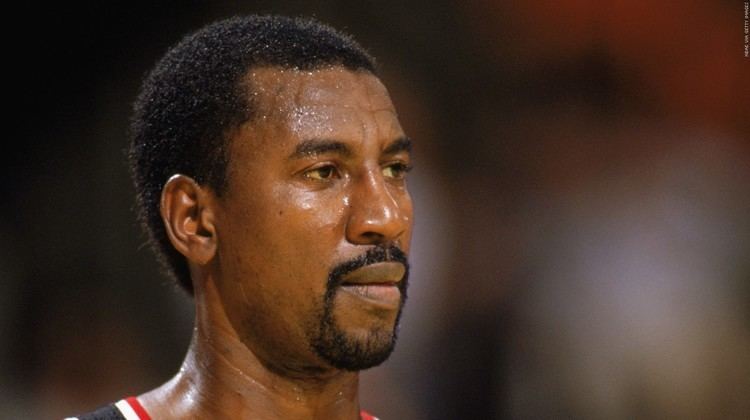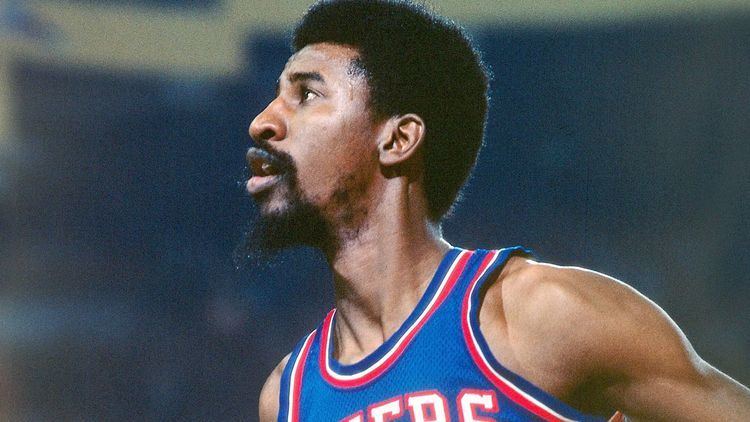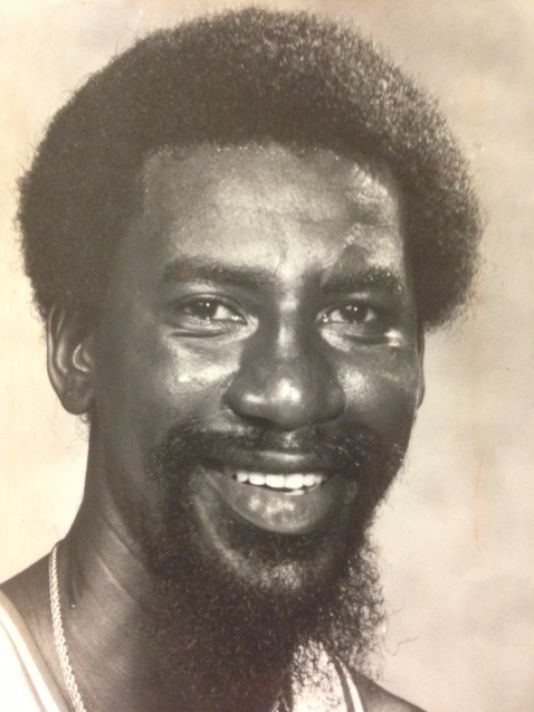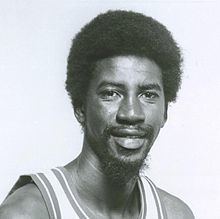Nationality American Role Basketball player Height 2.11 m | Listed weight 217 lb (98 kg) Name Caldwell Jones | |
 | ||
Born August 4, 1950McGehee, Arkansas ( 1950-08-04 ) College Albany State (1969–1973) NBA draft 1973 / Round: 2 / Pick: 32nd overall Spouse Vanessa Dorton (m. 1992–2014) Siblings Charles Jones, Major Jones, Wil Jones, Clovis, Oliver Jones, Clint Jones Similar People Major Jones, Wil Jones, Terry Stotts, Brett Brown | ||
Education Albany State University Listed height 6 ft 11 in (2.11 m) | ||
In Memoriam: Caldwell Jones
Caldwell "Pops" Jones (August 4, 1950 – September 21, 2014) was an American professional basketball player.
Contents

Jones was drafted from Albany State College (Georgia) by the Philadelphia 76ers with the 14th pick in the 1973 NBA draft. He played three seasons in the American Basketball Association and 14 seasons in the NBA, most extensively with the Philadelphia 76ers.

Jones led the ABA in blocked shots in the 1973–74 season, and played in the 1975 ABA All-Star Game. He shares (with Julius Keye) the ABA's all-time record for blocked shots in a game with 12.

Jones' brothers, Charles, Wil and Major all played at Albany State and in the NBA.

Caldwell jones 20pts vs spurs 1979 playoffs
Biography

The most prominent of four brothers who played in the NBA, Caldwell Jones was best known as the least flamboyant member of the high-powered Philadelphia 76ers teams of the late 1970s and early 1980s. Playing alongside Julius Erving and company, Jones didn't need to score much with Philadelphia, so he concentrated on rebounding, shotblocking, and defense. A lanky yet strong 6-foot-11 pivotman, his hustle, board work, and defense kept him in professional basketball for 17 years.
Playing in his final season at age 39, he was the fifth-oldest NBA player ever to have suited up at the time. He finished with 10,068 points (in the NBA and the American Basketball Association), but it had taken him 1,227 games to rack them up. No other player who scored 10,000 points had ever needed more than 1,200 games to do so.
"Everybody likes to look at the glorified part of the game, like scoring points", Jones told USA Today in 1990. "But there is a lot more to the game. I look at myself like an offensive lineman. Someone has to open the holes for the 1,000-yard rushers." "What do I think of Caldwell Jones? When he retires, I think they should have a farewell tour for him", Larry Brown, Jones's coach with the San Antonio Spurs, told USA Today.
Jones grew up in McGehee, Arkansas, a member of a very tall family. The 6-foot-3 Caldwell Jones, Sr., and his wife, 5-foot-11 Cecelia, had eight children. Their shortest child was Clovis, the only daughter, who measured in at 6-foot-3. Four of the Jones boys played in the NBA: Wilbert (6-foot-8, one season each with the Indiana Pacers and the Buffalo Braves, plus seven seasons with three ABA teams), Caldwell (five NBA and three ABA teams), Major (6-foot-9, five seasons with the Houston Rockets, one with the Detroit Pistons), and Charles (6-foot-9, 15 seasons total with Philadelphia, the Chicago Bulls, the Washington Bullets, Detroit and the Houston Rockets). Two other brothers played minor league basketball.
In the 37 NBA seasons accumulated by the four Jones brothers, only once did a Jones post a scoring average in double figures—Wilbert did it in 1976–77 with the Pacers, tallying 13.0 points per game. (However, between them the brothers had several double-figure scoring seasons in the ABA.)
Oliver Jones was the first of the Jones brothers to play basketball at Albany State in Georgia (and later became head coach for 28 years at the school). Five other brothers, including Caldwell, followed. For 18 straight seasons, a Jones occupied the center position for the Albany hoopsters.
Given these similarities, it was difficult to keep up with the Joneses. But it was Caldwell who most distinguished himself. He began in 1973–74 with the ABA's San Diego Conquistadors, coached by Wilt Chamberlain. During three ABA seasons (including short stints with the Kentucky Colonels and the Spirits of St. Louis), Jones averaged 15.8 points, hitting a career high of 19.5 points per game in 1974–75. "I was a gunner", he later told the Dallas Morning News. "Every time I caught the ball I shot it."
With the ABA–NBA merger prior to the 1976–77 season, Jones landed with Philadelphia. His days as a gunner were over. "We had so much talent on those 76er teams that [Coach] Gene Shue said all he wanted his centers to do was play defense and rebound. I had no argument with that", Jones later told the Portland Oregonian..."We were winning and that's the name of the game. And it's kept me around for 16 years."
In Jones's first season with Philadelphia, the team was particularly explosive. Erving (21.6 ppg), George McGinnis (21.4), Doug Collins (18.3), and Lloyd B. Free (later World B. Free) (16.3) propelled the squad to a 50-32 regular-season record and an NBA Finals meeting with the Portland Trail Blazers. Jumping out to a two-game lead, the Sixers appeared to be headed for the title, but the Trail Blazers rallied for an astounding four-games-to-two Finals win. For the season, Jones averaged 6.0 points and 8.1 rebounds and finished sixth on the team in minutes played. He also ranked fifth in the league in blocked shots with 200.
Philadelphia won the Atlantic Division again in 1977–78 but lost to Washington in the Eastern Conference Finals. Jones averaged 5.4 points (ninth on the team) and 7.0 rebounds (third). That season marked the emergence of Darryl Dawkins, with whom Jones shared minutes in the pivot during the following seasons.
In 1978–79 the 76ers slipped a bit, finishing second in the Atlantic Division to Washington and losing to the San Antonio Spurs in the conference semifinals. Jones averaged 9.3 points (his highest average at Philadelphia) and 9.6 rebounds and was ninth in the league in blocks with 157.
The 76ers reached the NBA Finals in 1980. Erving scored 26.9 points per game on the season, and Jones was a defensive force, pulling down 11.9 rebounds per game, fourth in the league, and blocking 162 shots, seventh in the league. Although Philadelphia finished behind the Boston Celtics in the regular season, the Sixers tore through the playoffs before coming up short against the Los Angeles Lakers in the Finals.
Caldwell Jones and teammate Bobby Jones (no relation) were NBA All-Defensive First Team selections for the next two seasons, and the Sixers made another trip to the NBA Finals and battled the Lakers in 1982. Philadelphia again fell in six games. After the season, the 76ers sent Caldwell Jones to Houston in a deal that brought Moses Malone to Philadelphia. The Sixers won the championship the following season.
Jones played two seasons in Houston (joining his brother Major on the Rockets squad), one in Chicago, four in Portland, and one in San Antonio. Primarily he was a reserve, called upon to spell the starting center, grab some rebounds, and play some defense. "I'm like a spare tire on the Cadillac", he told USA Today in the twilight of his career. "I'm just sitting around in the trunk, waiting to get put on the car if one of the fancy tires blows out".
Jones died of a heart attack while at a driving range in Stockbridge, Georgia on September 21, 2014. He was 64 years old.
